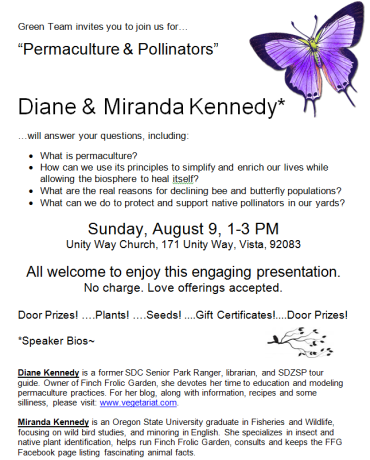Heirloom Plants
- Animals, Bees, Birding, Gardening adventures, Heirloom Plants, Natives, Other Insects, Perennial vegetables, Permaculture and Edible Forest Gardening Adventures, Predators, Rain Catching, Soil, Water Saving
Plant Guild #7: Vines
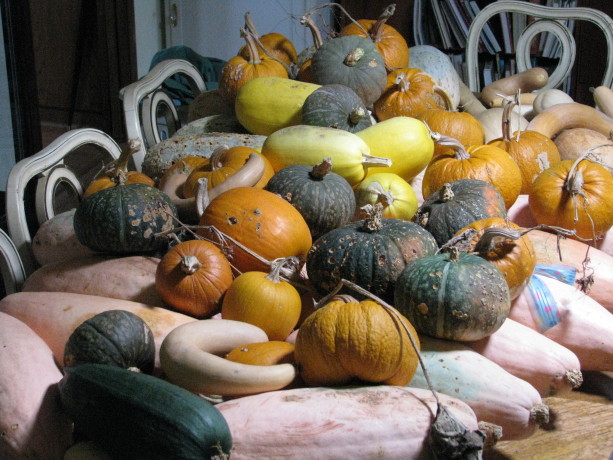
Our varieties of squash several years ago. You may think that vines and groundcover plants are pretty interchangeable, and they can share a similar role. However, as we covered in the Plant Guild #6: Groundcovers these plants do not have to vine, but just cover large spaces close to the ground and coming from a single trunk or stem.
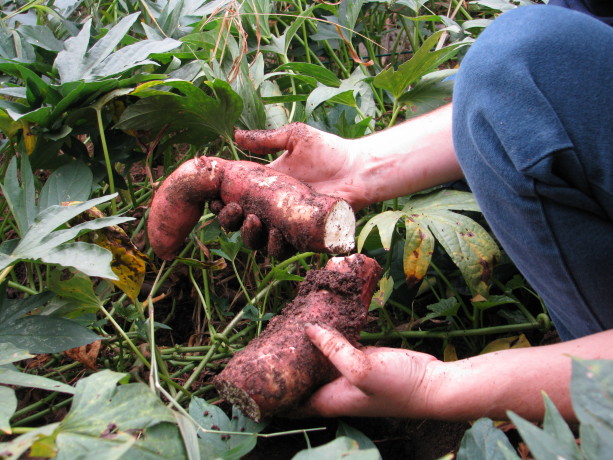
Sweet potatoes and yams make fantastic ground covers. The leaves are edible. Some root in one place, and some spread tubers over a larger area, so choose what is appropriate for digging up your harvest in your guild. They will die of frost. Vines can be large and heavy, small and delicate, perennial or annual. In a food plant guild vines are often food-bearing, such as squash. If you recall the legendary Three Sisters of planting – corn, beans and squash – there are two vines at work here. The corn forms a trellis for the light and grabby bean plant to climb upon (the bean fixing nitrogen in the soil as well as attracting pollinators with its flowers). The squash forms a low canopy all around the planted area. The big leaves keep moisture in, soften the raindrops to prevent erosion and deoxygenation, drop leaves to fertilize the soil, provide a large food crop, and attract larger pollinators. Even more than that, the squash protects the corn from raccoons. These masked thieves can destroy an entire backyard corn crop in a night, just when the corn is ripe. However, they don’t like walking where they can’t see the ground, so the dense squash groundcover helps keep them away.
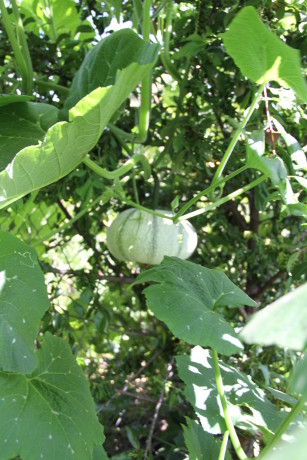
Pipian from Tuxpan squash supported by a plum and a pepper tree. Vines are very important to use on vertical space, especially on trees. With global warming many areas now have extremely hot to scorching sun, and for longer periods. Intense sun will scorch bark on tender trees, especially young ones. By growing annual vines up the trees you are helping shade the trunk while producing a crop, and if the vines are legumes you are also adding nitrogen fertilizer.
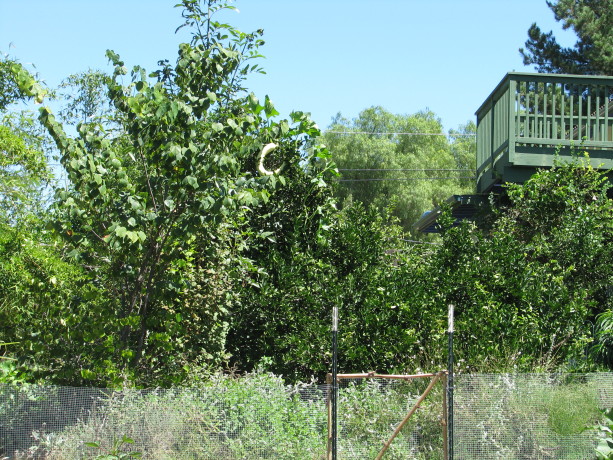
Can you spot the squash in the lime tree? It is crescent shaped and pale. Be sure the weight of the mature vine isn’t more than the tree support can hold, or that the vine is so strong that it will wind its way around new growth and choke it. Peas, beans and sweetpeas are wonderful for small and weaker trees. When the vines die they can be added to the mulch around the base of the tree, and the tree will receive winter sunlight. When we plant trees, we pop a bunch of vining pea (cool weather) or bean (warm weather) seeds right around the trunk. Larger, thicker trees can support tomatoes, cucumbers, melons, and squash of various sizes, as well as gourds. Think about how to pick what is up there! We allowed a alcayota squash to grow up a sycamore to see what would happen, and there was a fifteen pound squash hanging twelve feet above the pathway until it came down in a heavy wind!
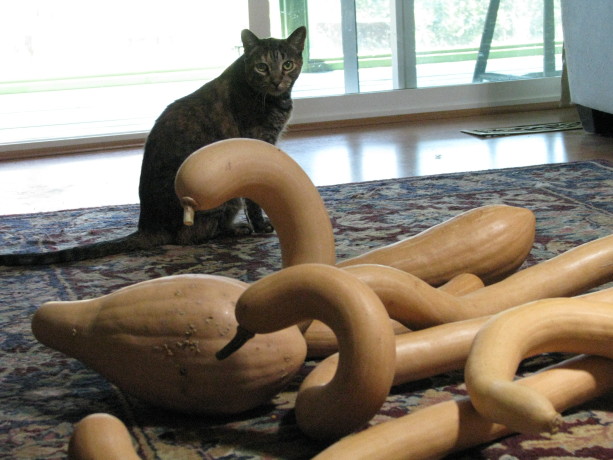
These zuchinno rampicante, an heirloom squash that can be eaten green or as a winter squash, form interesting shapes as they grow. These ‘swans’ and Marina are having a stare-off. Nature uses vertical spaces for vines in mutually beneficial circumstances all the time, except for notable strangler vines. For instance in Southern California we have a wild grape known as Roger’s Red which grows in the understory of California Live Oaks. A few years ago there appeared in our local paper articles declaiming the vines, saying that everyone should cut them down because they were growing up and over the canopy of the oaks and killing them. The real problem was that the oaks were ill due to water issues, or beetle, or compaction, and had been losing leaves. The grape headed for the sun, of course, and spread around the top of the trees. The overgrowth of the grape wasn’t the cause of the problem, but a symptom of a greater illness with the oaks.
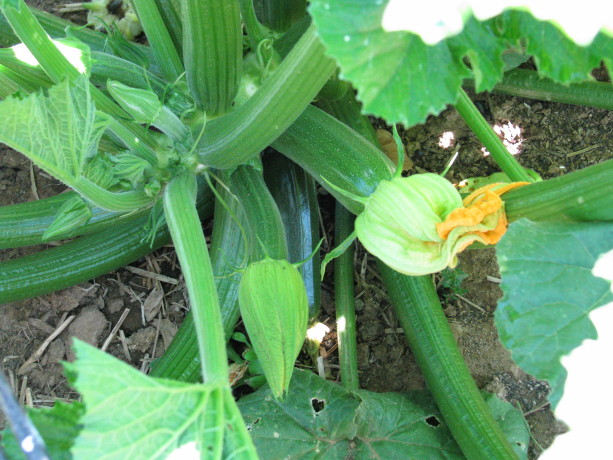
Zucchini! Some vines are not only perennial, but very long-lived and should be placed where they’ll be happiest and do the most good. Kiwi vines broaden their trunks over time and with support under their fruiting stems can be wonderful living shade structures. A restaurant in Corvallis, Oregon has one such beauty on their back patio. There is something wonderful about sitting in the protection of a living thing.
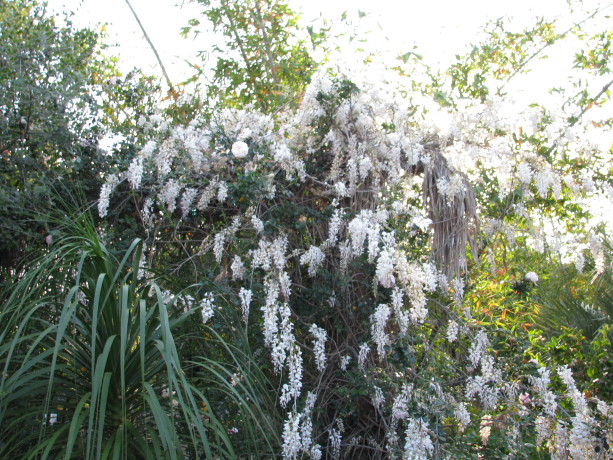
Wisteria chinensis is a nitrogen-fixer with edible flowers (and poisonous other parts), has stunning spring flowers and can make a nice deciduous vine to cover a canopy. It does spread vigorously, but can be trained into a standard, and are fairly drought tolerant when mature. Passionvines can grow up large trees where they can receive a lot of light. Their fruit will drop to the ground when ripe. The vines aren’t deciduous, so the tree would be one where the vine coverage won’t hurt the trunk.
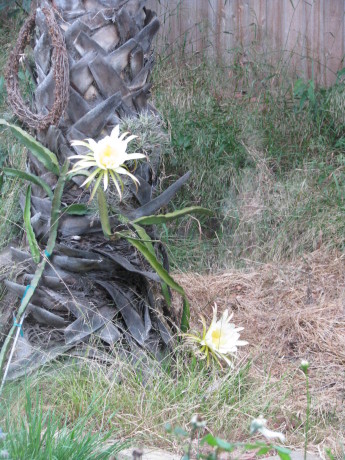
Dragonfruit aren’t exactly a vine, but they can be trained up a sturdy tree. Vines such as hops will reroot and spread wherever they want, so consider this trait if you plant them. Because the hops need hand harvesting and the vines grow very long, it is probably best to put them on a structure such as a fence so you can easily harvest them.
So consider vines as another important tool in your toolbox of plants that help make a community of plants succeed.
Next in the Plant Guild series, the last component, Insectiaries. You can find the entire 9-part Plant Guild series here: Plant Guilds: What are they and how do they work? The first in a series. , Plant Guild #2: Canopy , Plant Guild #3: Sub-Canopy , Plant Guild #4: Nitrogen-Fixers, Plant Guild #5: Mining Plants, Plant Guild #6: Groundcovers, Plant Guild #8: Insectiaries, Plant Guild #9: The Whole Picture.
- Animals, Bees, Birding, Compost, Fungus and Mushrooms, Gardening adventures, Health, Heirloom Plants, Hugelkultur, Microbes and Fungi, Natives, Other Insects, Perennial vegetables, Permaculture and Edible Forest Gardening Adventures, Predators, Rain Catching, Reptiles and Amphibians, Seeds, Soil, Water, Water Saving, Worms
Plant Guild #6: Groundcover Plants

Artichokes are mining plants, but also have a low enough profile to be a groundcover plant. They make excellent chop-and-drop. Flanking are lavender, scented geranium (left), and borage. In most ecosystems that offer easy food for humans, the ground needs to be covered. Layers of leaves, organic matter from animals (poo, fur, carcasses, meal remains, etc.) , dropped branches and twigs, fallen flowers and fruit, and whatever else gravity holds close to the earth, compost to create soil and retain water and protect the soil from erosion and compaction. Areas that don’t have this compost layer are called deserts. If you want to grow an assortment of food for humans, you have to start building soil. Even in desert communities where there are some food plants growing, such as edible cactus, mesquite beans, etc., there is biodiversity on a more microscopic scale than in old growth forests. In deserts the soil needs to absorb what little rain there is and do it quickly before it evaporates, and plants have leaves adapted to have small leaf surfaces so as not to dry out, and there are few leaves to drop. Whereas in areas where there are large forests the weather is usually wetter, tall plants and thick underbrush provide multiple layers of protection both on the plants and when they fall to layer the earth.
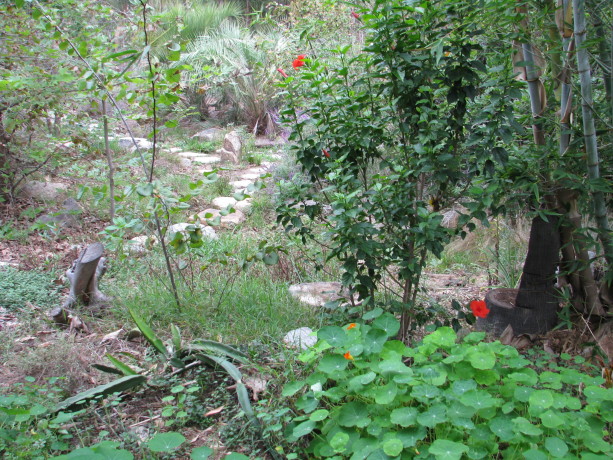
Nasturtium reseeds itself annually, is edible with a bite of hotness, detracts aphids from other plants, and is charming. Don’t let it get away in natural areas, though. A quick way to build soil in plant guilds is to design for plants that will cover the ground. This isn’t necessarily the same groundcover as you would use to cover embankments. For instance, iceplant can be used in a pinch, but it really isn’t the best choice in most plant guilds unless you are in a very dry climate, and your plant guild is mostly desert-type plants: date palm, etc. Annuals can be squash or other aggressive food-producing vines such as unstaked tomatoes. However you don’t need to consider just ground-hugging plants; think sprawling shrubs.
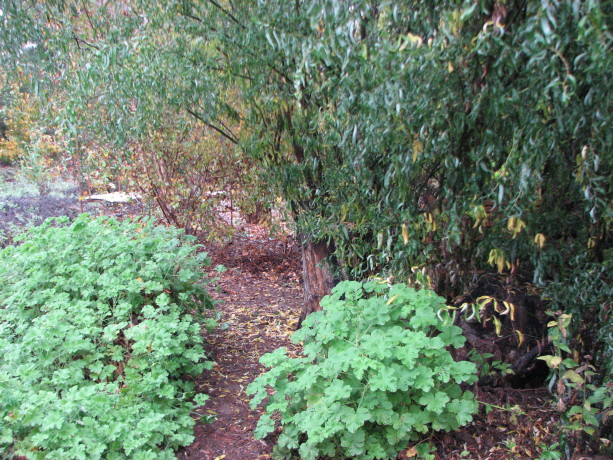
Scented geraniums are a great ‘placeholder plant’. These Pelargoniums (not true geraniums) come in a wide variety of fragrances. We’ve found bird nests in these! When guests tour through Finch Frolic Garden, they often desire the lush foresty-feel of it for their own properties, but have no idea how to make it happen. This is where what I call ‘placeholder plants’ come in. Sprawling, low-cost shrubs can quickly cover a lot of ground, protect the soil, attract insects, often be edible or medicinal, be habitat for many animals, often can be pruned heavily to harvest green mulch (chop-and-drop), often can be pruned for cuttings that can be rooted for new plants to use or to sell, and are usually very attractive. When its time to plant something more useful in that area, the groundcover plant can be harvested, used for mulch, buried, or divided up. During the years that plant has been growing it has been building soil beneath it, protecting the ground from compaction from the rain. There is leave mulch, droppings from lizards, frogs, birds, rabbits, rodents and other creatures fertilizing the soil. The roots of the plant have been breaking through the dirt, releasing nutrients and developing microbial populations. Some plants sprawl 15′ or more; some are very low-water-use. All of this from one inexpensive plant.
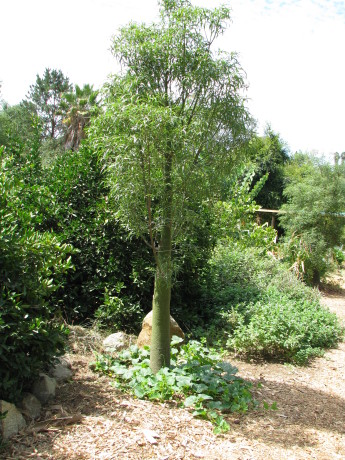
Squash forms an annual groundcover around the base of this euphorbia. Depending upon your watering, there are many plants that fit the bill, and most of them are usable herbs. Scented geraniums (Pelargonium spp.), lavender, oregano, marjoram, culinary sage, prostrate rosemary, are several choices of many plants that will sprawl out from one central taproot. Here in Southern California, natives such as Cleveland sage, quail bush (which harvests salt from the soil), and ceanothus (California lilac, a nitrogen-fixer as well), are a few choices. Usually the less water use the plant needs, the slower the growth and the less often you can chop-and-drop it. With a little water, scented geraniums can cover 10 – 15 feet and you can use them for green mulch often, for rooted cuttings, for attracting insects, for medicine and flavoring, for cut greenery, for distillates if you make oils, etc.
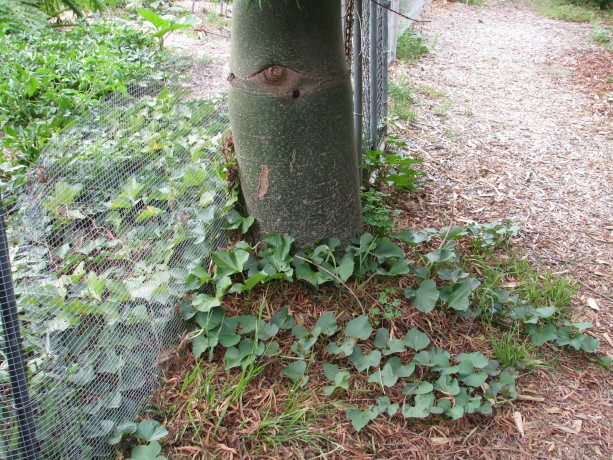
Sweet potatoes make a great ground cover. Choose varieties that produce tubers directly under the plant rather than all along the stems so that you don’t have to dig up your whole guild to harvest. Groundcover plants shouldn’t be invasive. If you are planting in a small guild, planting something spreading like mint is going to be troublesome. If you are planting in larger guilds, then having something spreading in some areas, such as mint, is fine. However mint and other invasives don’t sprawl, but produce greenery above rootstock, so they are actually occupying more space than those plants that have a central taproot and can protect soil under their stems and branches. Here at Finch Frolic Garden, we have mint growing freely by the ponds, and in several pathways. Its job is to crowd out weeds, build soil, and provide aromatherapy. I’d much rather step on mint than on Bermuda grass, and besides being a superb tea herb, the tiny flowers feed the very small bees, wasps and flies that go unsung in gardens in favor of our non-native honeybees (there are no native honeybees in North America).
Here’s a general planting tip: position plants with fragrant leaves and flowers near your pathways for brush-by fragrance. You should have a dose of aromatherapy simply by walking your garden path. Mints are energizing, lavenders calming, so maybe plan your herbs with the pathways you take in the morning and evening to correspond to what boost you need at that time.
Consider groundcover plants and shrubs that will give you good soil and often so much more.
Next up: Vining Plants.
You can find the entire 9-part Plant Guild series here: Plant Guilds: What are they and how do they work? The first in a series. , Plant Guild #2: Canopy , Plant Guild #3: Sub-Canopy , Plant Guild #4: Nitrogen-Fixers, Plant Guild #5: Mining Plants, Plant Guild #7: Vines, Plant Guild #8: Insectiaries, Plant Guild #9: The Whole Picture.
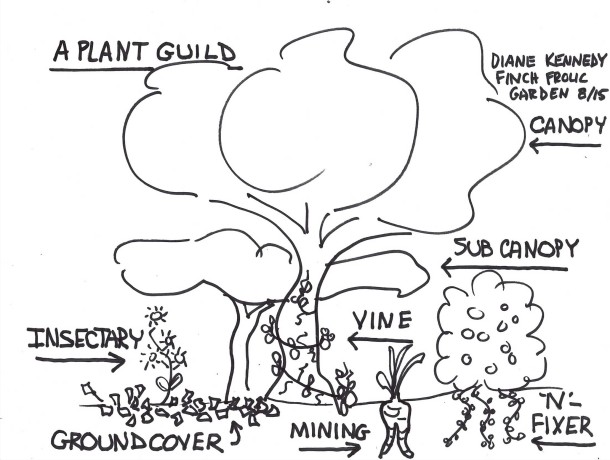
What makes up a plant guild. - Animals, Birding, Building and Landscaping, Chickens, Compost, Fungus and Mushrooms, Gardening adventures, Health, Heirloom Plants, Houses, Hugelkultur, Microbes and Fungi, Natives, Other Insects, Perennial vegetables, Permaculture and Edible Forest Gardening Adventures, Ponds, Predators, Rain Catching, Reptiles and Amphibians, Seeds, Soil, Water, Water Saving
Podcasts with Diane Kennedy
Two podcasts with me talking about permaculture, Finch Frolic Garden, and how you can save money and the world through gardening! 🙂 Please let me know what you think:
This is a podcast with Sheri Menelli of earthfriendlyhomeowner.com, where I talk pretty much without a pause for breath for about the first ten minutes. Recorded in May, 2015.
http://www.earthfriendlyhomeowner.com/ep7-interview-with-diane-kennedy-of-finch-frolic-gardens-and-vegetariat-com/
This is a podcast with Greg Peterson of Urban Farm Podcasts, released Jan. 7, 2016, and you can listen to it several ways:
Urban Farm U:
http://www.urbanfarm.org/category/podcast/
iTunes:
https://itunes.apple.com/us/podcast/urban-farm-podcast-greg-peterson/id1056838077?mt=2
You can sign up for free to hear all their great podcasts here.
- Compost, Gardening adventures, Heirloom Plants, Hugelkultur, Natives, Perennial vegetables, Permaculture and Edible Forest Gardening Adventures, Seeds, Water Saving, Worms
Plant Guild #5: Mining Plants
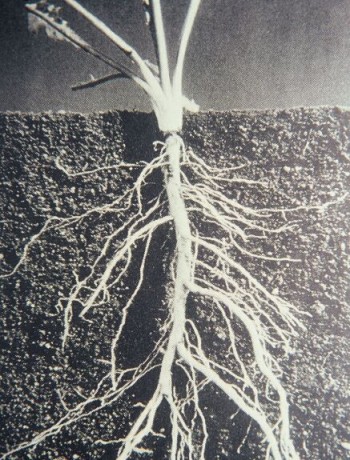
The beauteous taproot. In the last post we explored one way plants take nitrogen out of the air and fix it in the soil. Now we’ll explore how plants take nutrients from deep in the soil and deliver them to the soil surface. This is another way that plants create high nutrient topsoil.
All rooted plants gather nutrition from the soil, store it in their leaves, flowers and fruit, and then create topsoil as these products fall to the ground. Every plant is a vitamin pill for the soil. When you pull ‘weeds’, clear your garden, prune and otherwise amass greenery and deadwood, you are gathering vitamins and minerals for your soil. Bury it. All of it. If its too big to bury, then chip it and use it as top mulch. Allow that nutrition to return to the soil from whence it came. No stick or leaf should leave your property! Period.
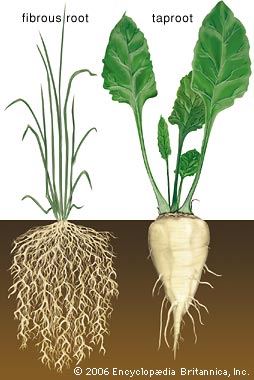
Fiberous roots hold soils together, and taproots dig. There are mainly two kinds of root systems: fibrous (like many grasses) and taprooted. Some taprooted plants grow very deeply. Those plants that are deemed ‘mining’ plants go the extra mile. I envision mining plants as the gruff gentlemen of the plant guild: tough and weathered, dressed in pith helmet and explorer clothes with a larger-than life character and a heart of gold.

A monument to Sir Henry Morton Stanley. I don’t know if he had a heart of gold or was gruff. Okay, too many old movies on my part. The roots of mining plants are large taproots that explore the depth of the soil searching for deep water. Depending upon the size of the plant, these roots can break through hardpan and heavy soils. They create oxygen and nutrient channels, digging tunnels that weaker roots from less bold plants and soft-bodied soil creatures can follow. When these large roots die they decompose deep in the ground, bringing that all-important organic material into the soil to feed microbes. Meanwhile these Indiana Jones’s of the root world are finding pockets of minerals deep in the soil – far below the topsoil and where other roots can’t reach – and are taking them into their bodies and up into their leaves. When these leaves die off and fall to the ground they are a super rich addition to the topsoil. Often the deep taprooted plants have a sharp scent or taste. Many weeds found in heavy soils are mining plants, sent by Mother Nature to break up the dirt and create topsoil. Dicotyledonous (dicot) plants have deep taproots, if you are into that kind of thing. The benefits of a plant having a deep taproot is not only to search for deep water, but to store a lot more sugar in the root, be anchored firmly, and to withstand drought better.
So who are these helpful gentlemen adventurers of the plant guilds? Comfrey and artichoke are two commonly used mining plants. Also members of the, radish, mustard, and carrot family such as, parsnip, root celery, horseradish, burdock, parsley, dandelion, turnip, and poppy to name a few. There is also milkweed (Asclepias), coneflower, chicory, licorice, pigeon pea, and for California natives there is sagebrush, Matilija poppy, oaks, mesquite, Palo Verde and many more. Most deep taprooted plants don’t transplant well because their straight taproot is often much longer than the top of the plant. Check out a sprouted acorn. The taproot is many times as deep as the top is high.
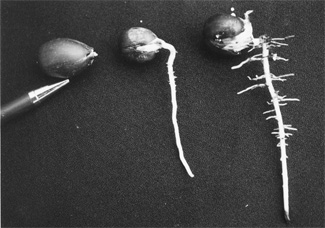
Three day’s difference in germinating acorns. Talk about taproot! Image from www.landscapeonline.com. Yet some mining plants such as comfrey and horseradish can be divided or will sprout from pieces of the root left in the ground. Deep taprooted weeds seem to all be like that, at least on my property!

Horseradish: the root is edible and medicinal, and the leaves are a spicy treat! 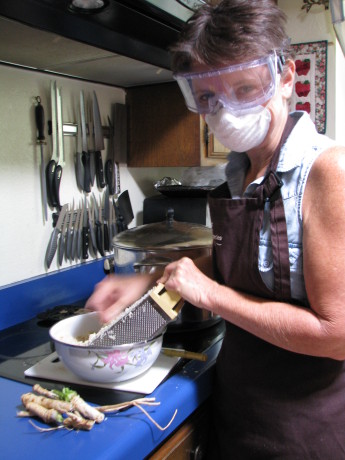
Grating horseradish for sauce, and still tearing up! Now for a little comfrey prosthelytizing: Comfrey keeps coming back when chopped, so it is often grown around fruit producing trees to be chopped and dropped as a main fertilizer. Its leaves are so high in nutrition that they are a compost activator, an excellent hen and livestock food (dried it has 26% protein), and have been heavily used in traditional medicine. Also called Knitbone, the roots contain allantoin, a substance also found in mother’s milk, which among other benefits helps heal bone breaks when applied topically.
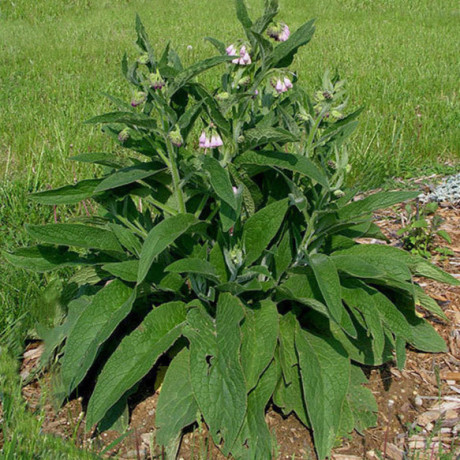
A handsome comfrey plant working in the garden. The plant also has flowers that bees and other insects love. It spreads by seeds as well as divisions, and non-permaculture gardeners don’t like it escaping in their gardens. I only wish that mine would spread faster, to create more fertilizer. Comfrey grows the best greens with some irrigation and better soil, so it is perfect for use around fruit trees.
So when planting a guild you can easily plant miners that are edible. If you harvest those deep taproots, such as carrots or parsnips, then be sure to trim the greens and let them fall on the spot, so the plant will have done its full duty to the soil. Unless the plant can take division, such as the aforementioned comfrey, then planting seeds are best. Deep taprooted plants in pots are often stunted and either don’t survive transplanting well, or will take a long time to grow on top because they need to grow so much on the bottom first.
Next up: the exciting groundcover plants!
You can find the entire 9-part Plant Guild series here: Plant Guilds: What are they and how do they work? The first in a series. , Plant Guild #2: Canopy , Plant Guild #3: Sub-Canopy , Plant Guild #4: Nitrogen-Fixers, Plant Guild #6: Groundcover Plants, Plant Guild #7: Vines, Plant Guild #8: Insectiaries, Plant Guild #9: The Whole Picture.
- Animals, Bees, Birding, Compost, Fungus and Mushrooms, Gardening adventures, Heirloom Plants, Hugelkultur, Living structures, Natives, Other Insects, Perennial vegetables, Permaculture and Edible Forest Gardening Adventures, Photos, Ponds, Rain Catching, Recycling and Repurposing, Reptiles and Amphibians, Seeds, Soil, Water, Water Saving, Worms
October Garden
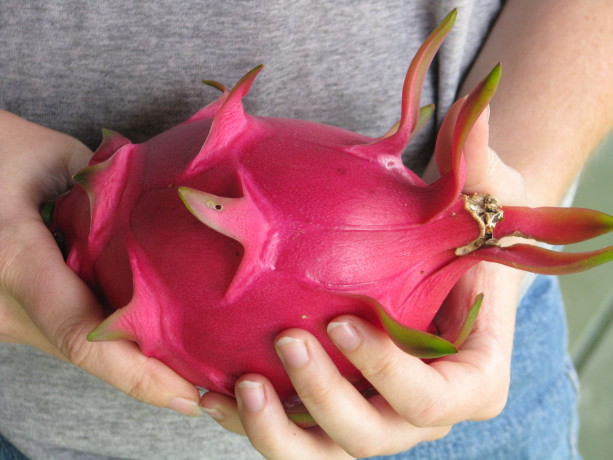
A huge dragonfruit; this kind is white inside. October is one of my favorite months, even when we’re on fire here in Southern California. This year we’ve been saved, and October is moderate in temperature and lovely.
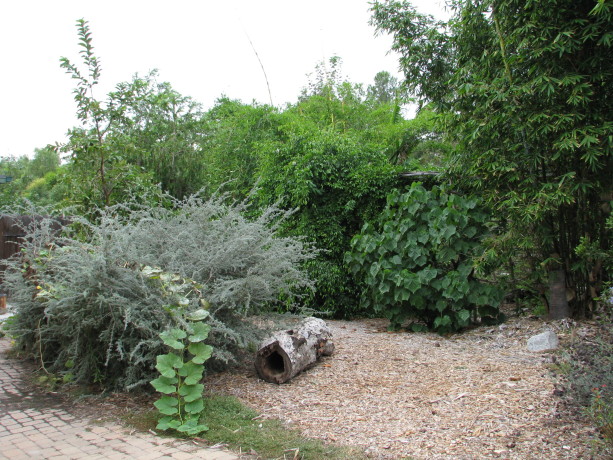
A volunteer kabocha squash vining its way through a bush. 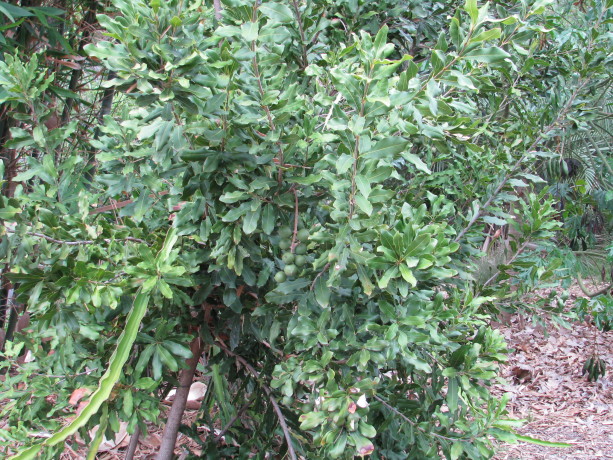
Our first ripeing macadamia harvest from a 3 year old tree, with a dragonfriuit snaking through. 
Edible hibiscus, volunteer nasturtiums and pathway across the rain catchment basin. 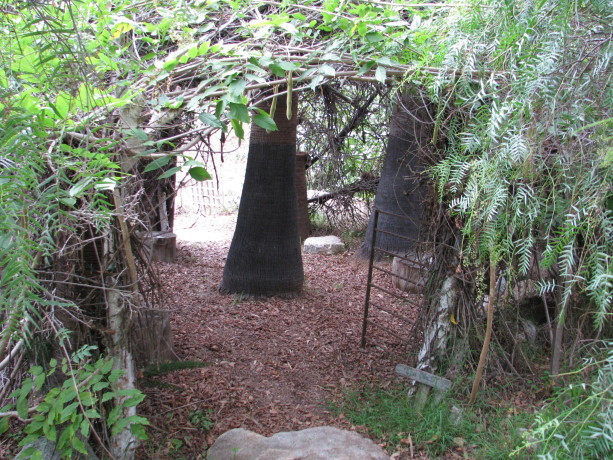
Into the wisteria-covered Nest. Summer has lost her vicious grip and we have time until the holiday rush and winter cold. Finch Frolic Garden has withstood the heat, the dry, the inundations, the snow and the changes, all without chemicals or much human intervention.
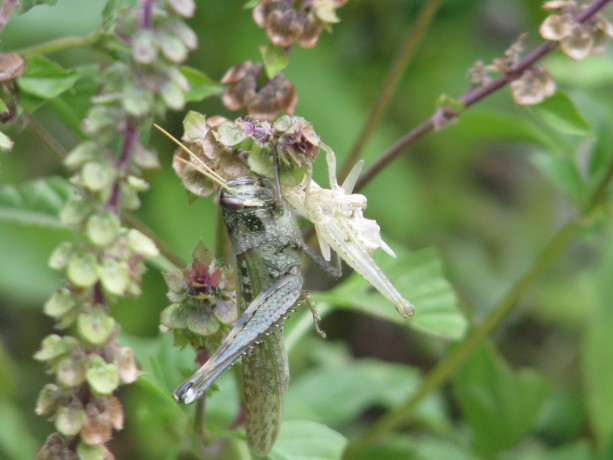
Grasshopper freshly out of last instar. 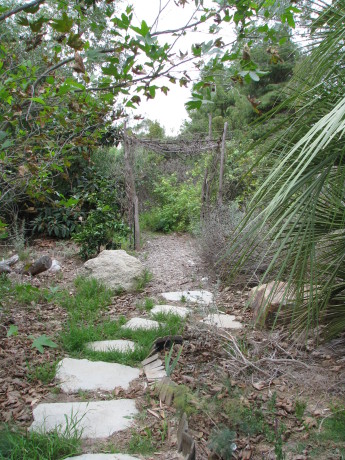
The curly willow trellis. We’ve lost some trees and shrubs this year, but that is mostly due to the faulty irrigation system which delivers too much or too little, and is out of sight underground.
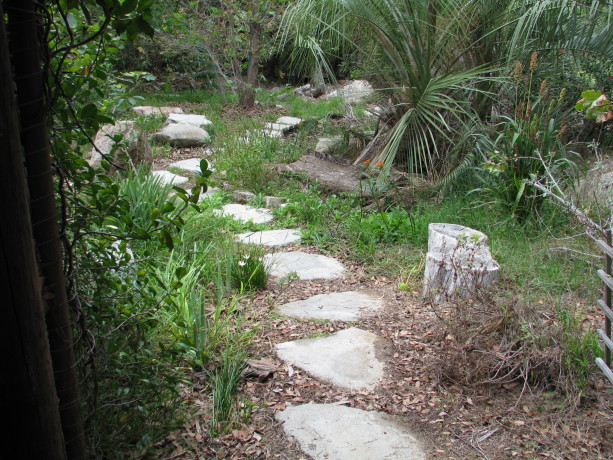
Urbanite pathway. 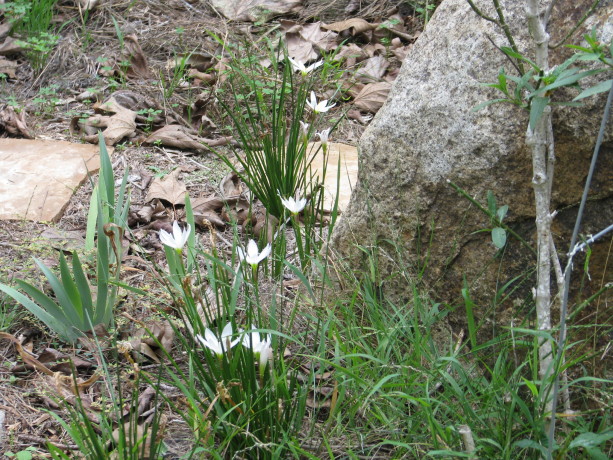
Bulbs will pop up year round for wonderful surprises. Permaculture methods in sheet mulching, plant guilds, swales, rain catchment basins, and the use of canopy have pulled this garden through.
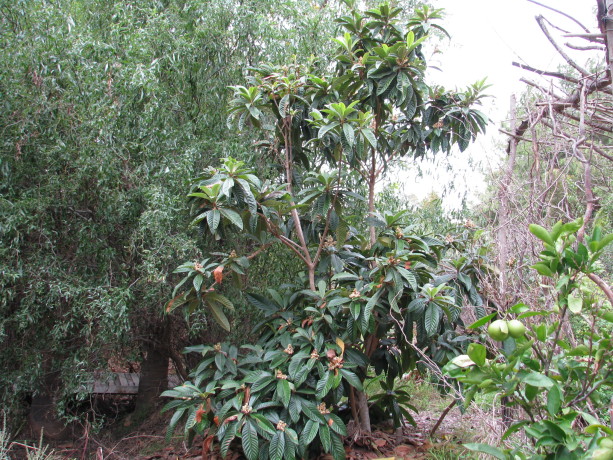
Loquat in bloom. 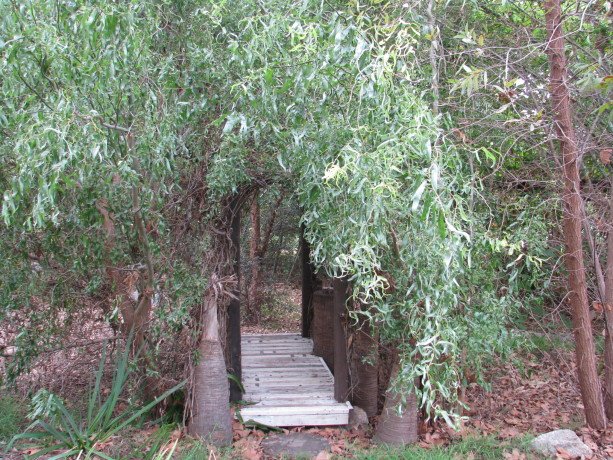
Bridge over currently dry streambed. 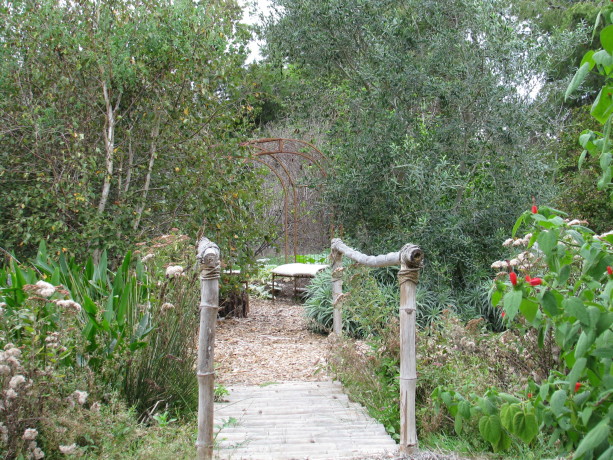
Bamboo bridge. 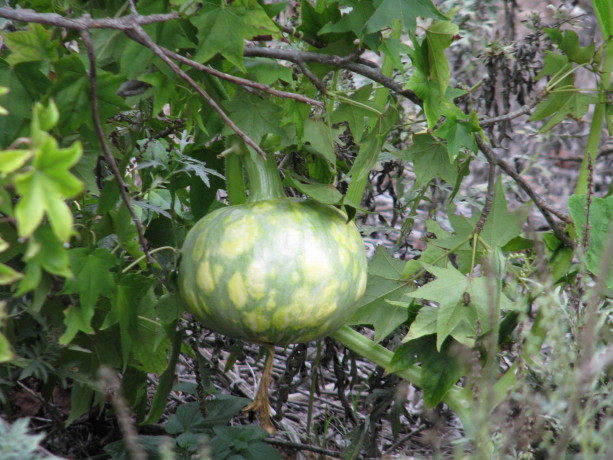
A gourd in a liquidamber. The birds, butterflies and other insects and reptiles are out in full force enjoying a safety zone. A few days ago on an overcast morning, Miranda identified birds that were around us: nuthatches, crows, song sparrows, a Lincoln sparrow, spotted towhees, California towhees, a kingfisher, a pair of mallards, a raven, white crowned sparrows, a thrush, lesser goldfinches, house finches, waxwings, robin, scrub jays, mockingbird, house wren, yellow rumped warbler, ruby crowned kinglet, and more that I can’t remember or didn’t see.
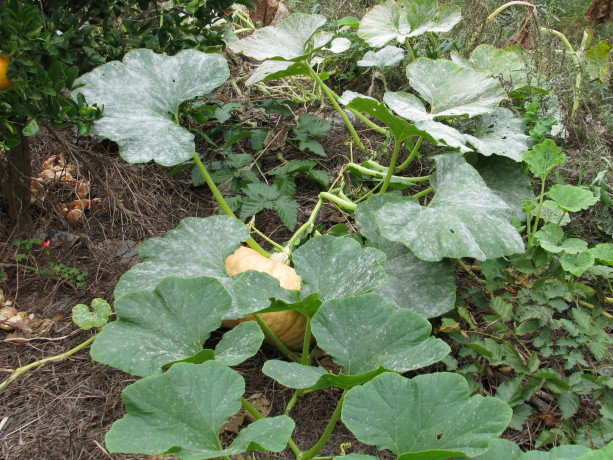
Squash! 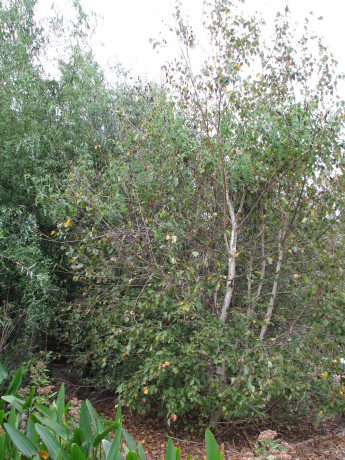
This birch has strange red fruit in its top boughs… 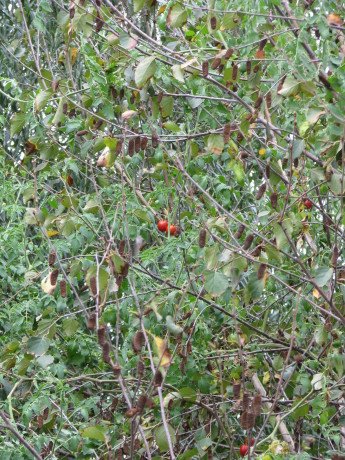
…a volunteer cherry tomato that is fruiting inconveniently ten feet up. Birds have identified our property as a migratory safe zone. No poisons, no traps. Clean chemical-free pond water to drink. Safety.

Squash and gourds happily growing out of the hugelkultur mound. 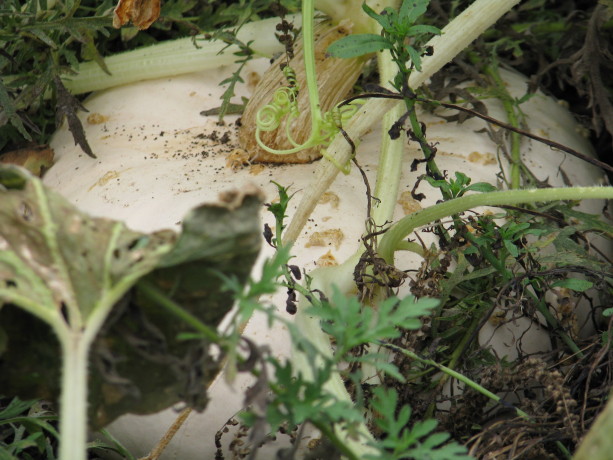
A surprise pumpkin hiding in the foliage. 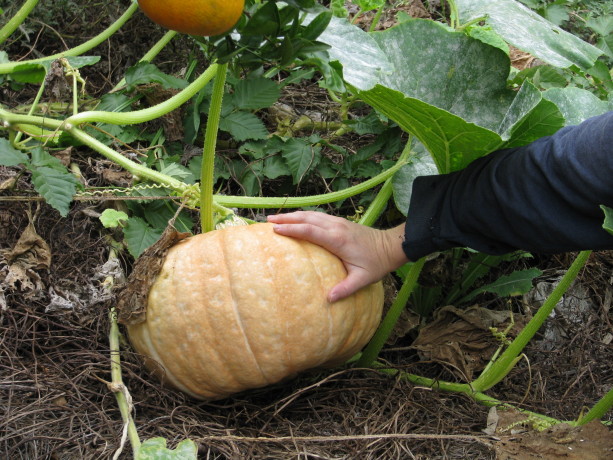
A huge and lovely gourd. 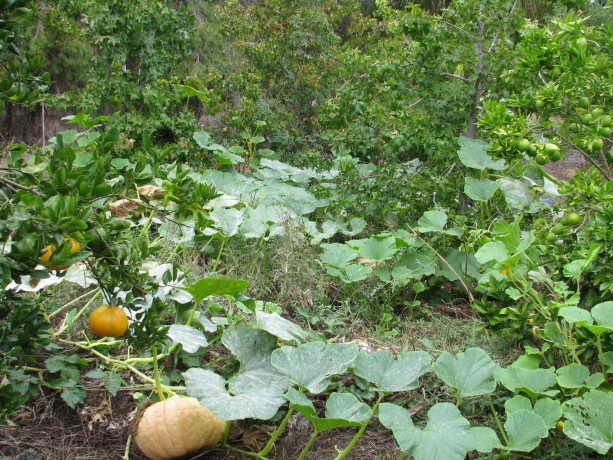
Vines taking advantage of vertical spaces by going up the trees. You can provide this, too, even in just a portion of your property. The permaculture Zone 5.
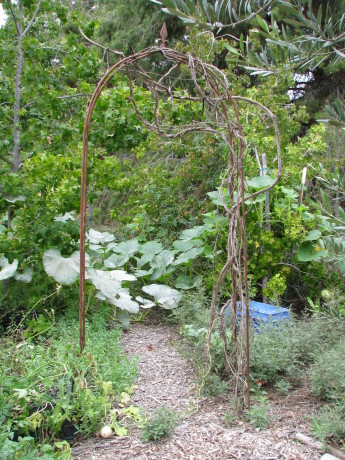
Why did the gourd cross the road? To climb up a liquidamber, apparently. 
A glimpse of pond through the withy hide 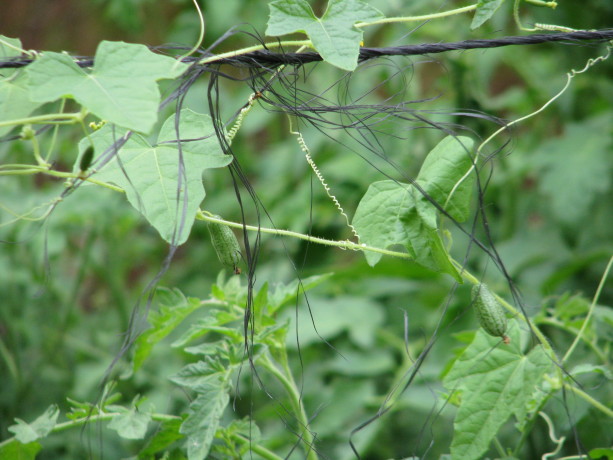
Mouse melons on a tiny vine. More cucumber than melon, they grow to be olive-sized. 
Time for me to get in the water and trim back the waterlilies before the water temperature drops! 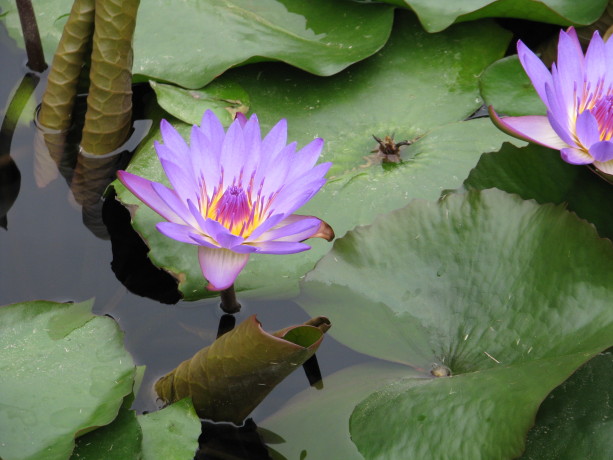
Purple water lilies in the pond. I’m indulging in showing you photos from that overcast October morning, and I hope that you enjoy them.

Eden rose never fails. 
Sweet potato vines escaping the veggie garden; the leaves are edible. 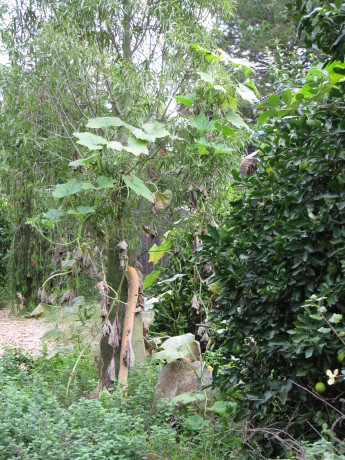
See the long tan thing on the trunk? That’s a zucchino rampicante, an Italian zucchini. Eat it green, or leave it to become a huge winter squash. 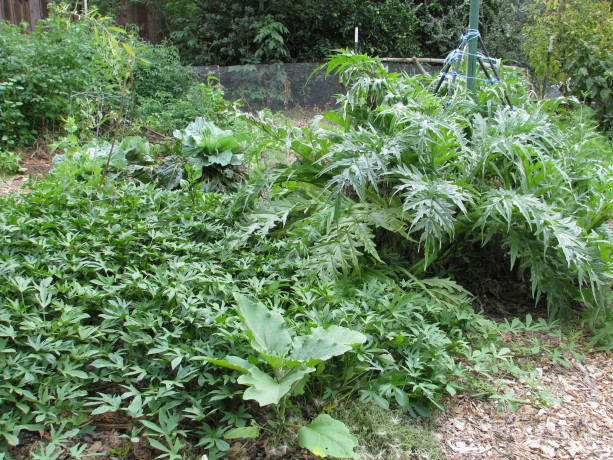
Violetta artichokes regrowing in our veggie garden, with a late eggplant coming up through sweet potato vines. - Animals, Compost, Fungus and Mushrooms, Gardening adventures, Heirloom Plants, Natives, Other Insects, Perennial vegetables, Permaculture and Edible Forest Gardening Adventures, Pets, Predators, Recipes, Reptiles and Amphibians, Seeds, Soil, Worms
Argentine Ants
Most of the annoying ants we suffer with in California, especially here in San Diego, are actually an invader called Argentine Ants. They arrived via shipboard to Louisiana, and have spread throughout warmer climates. Argentine ants are so successful because they have multiple queens per colony and therefore recognize all other Argentine ants as family. They don’t fight among themselves. There is a colony that stretches from San Diego to near San Francisco.
Argentine ants have nudged out many of our native ants, which isn’t a good thing. We need our native ants for decomposition. Argentine ants harm arthropods and have a terrible effect on the ecosystem; here in Southern California their impact on horned lizards have been devastating. The only way you can tell them apart (unless you have very tiny ants or black or red ants) from natives of similar size is by studying them with a microscope. This blog post shows great photos of the difference between ants.
Argentine ants farm aphids on plants and trees, milking the bugs for their ‘honeydew’, a sweet excretion. They will bring aphids to your plants and farm them there. They will also farm scale underground around the trunks or stems of plants, especially natives such as California Lilac (ceanothus spp). By the time the plant show stress and the ants begin to farm aphids above ground, much of the damage has already been done.
As much against annihilation as I am, this ant does terrible harm to our environment and should be happily living back in its native South American river area. Not only is it directly harmful, but because it is everywhere it incites people to spray poisons that kill all the beneficial insects as well.
The best solution is a borax bait trap that you can make your own. Borax is a powerful killer and should not be used liberally. Yes, it is sold as a fertilizer and as a laundry additive, and that borax kills insects and beneficial flora and fauna as it enters the watershed and soil. It is toxic to pets and children. However, just a little solution used wisely can really help control these ants.
I use old spice containers that have the plastic shaker ends on them for the bait traps. The holes are small enough to prevent other insects or animals from entering the jar, but are big enough for the ants. Otherwise you can use butter tubs with small holes punched in the top. Put a cotton ball inside the containers.
It is recommended to make a 1% borax solution rather than a stronger one because you don’t want to kill the ants immediately. You want them to bring the bait back to the nest and feed it to the queen. I know that is horrible, but they would definitely do the same to us if they could.
This recipe is based on research done by entomologist John Klotz at UC Riverside. Dissolve 1 tsp. boric acid (borax) and 6 tablespoons sugar in two cups of warm -preferably distilled or dechlorinated – water. Soak cotton balls in the bait solution and place in spice shakers or plastic tubs with holes in the lid. The containers will also keep the cotton ball from drying out quickly. Place in a shady location in the path of Argentine ants. Clean the container and replace the cotton ball weekly (it will become moldy). At first the bait traps will attract more ants, which is fine because they are bringing the bait back to their nests. If you want to kill the ants immediately, add more boric acid. For long-term control, reduce the boric acid to 1/2% to allow worker ants to feed for a long time before they die and therefore bring more back to the nest.
Keep the excess boric acid solution capped and in the refrigerator well labeled, so no one drinks the sweet drink.
Be sure to keep an eye out for ant activity around the base of your native plants, and if you have aphids on the leaves of plants you no doubt have ants farming them there. Argentine ants are pests we really can eliminate without fear, and allow our native ants to reclaim their territory.
- Animals, Bees, Birding, Compost, Fungus and Mushrooms, Gardening adventures, Health, Heirloom Plants, Microbes and Fungi, Natives, Other Insects, Perennial vegetables, Permaculture and Edible Forest Gardening Adventures, Pets, Ponds, Predators, Quail, Reptiles and Amphibians, Water, Water Saving, Worms
Permaculture and Pollinators lecture
- Animals, Bees, Birding, Building and Landscaping, Chickens, Compost, Fungus and Mushrooms, Gardening adventures, Heirloom Plants, Hugelkultur, Microbes and Fungi, Natives, Other Insects, Perennial vegetables, Permaculture and Edible Forest Gardening Adventures, Pets, Ponds, Predators, Quail, Rain Catching, Recycling and Repurposing, Seeds, Soil, Special Events, Water, Water Saving, Worms
Water Harvesting With Simple Earthworks
Finch Frolic Garden’s Program In The Garden Series for June:
Shaping the land to harvest energy and water – easily!
With permaculturalist Jacob Hatch of Hatch Aquatics and Landscaping
Use 30% – 70% less water on your landscape!
Jacob Hatch of Hatch Aquatics will show you how to catch free, precious, neutral pH rainwater using earthworks. Whether you use a trowel or a tractor, you can harvest that free water. Each attendee will receive a plant! We will, of course, offer homemade vegetarian refreshments. Cost is $25 per person, mailed ahead of time. Finch Frolic Garden is located at 390 Vista del Indio, Fallbrook. Please RSVP to dianeckennedy@prodigy.net . More information can be found at www.vegetariat.com. You’ll love what you learn!
- Animals, Bees, Birding, Compost, Fungus and Mushrooms, Gardening adventures, Health, Heirloom Plants, Houses, Hugelkultur, Microbes and Fungi, Natives, Other Insects, Perennial vegetables, Permaculture and Edible Forest Gardening Adventures, Ponds, Predators, Quail, Rain Catching, Recycling and Repurposing, Reptiles and Amphibians, Soil, Vegetables, Water, Water Saving, Worms
My Plea Against Gravel
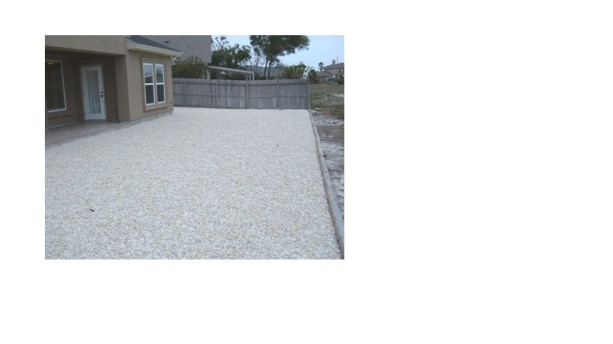 Here in Southern California, as in many other areas, we are finally legally recognizing the drought. There are rebates in place for those who take out their lawns, and here in Fallbrook there is a 36% water reduction goal. Many people just don’t know what to do with all that lawn. A very unfortunate continuing trend is to dump half a ton of colored gravel on it. Please! NO! First of all, once down gravel is nearly impossible to get out again. Gravel, like all rocks, is thermal mass. Instead of having a large rock heating up and radiating out heat, with gravel there are tens of thousands of surfaces radiating out heat and reflecting light and heat back up. It is the worst kind of hardscape. All that reflected heat and light heats up your home, making you use your air conditioner more frequently which is a waste of energy, and also dries out the air around your home. Desertification reflects light and heat to a point where moist air moving over a region dries up. There is less rain, or no rain. Most trees and plants trap humidity under their leaves. Gravel reflects light and heat back up under those leaves and dries them out, sickening your plants and trees. Pollen travels farther on humid air; it can dry out quickly. If you are relying on pollination for good fruit set between trees that are spaced far apart, then having some humidity will increase your chances of success.
Here in Southern California, as in many other areas, we are finally legally recognizing the drought. There are rebates in place for those who take out their lawns, and here in Fallbrook there is a 36% water reduction goal. Many people just don’t know what to do with all that lawn. A very unfortunate continuing trend is to dump half a ton of colored gravel on it. Please! NO! First of all, once down gravel is nearly impossible to get out again. Gravel, like all rocks, is thermal mass. Instead of having a large rock heating up and radiating out heat, with gravel there are tens of thousands of surfaces radiating out heat and reflecting light and heat back up. It is the worst kind of hardscape. All that reflected heat and light heats up your home, making you use your air conditioner more frequently which is a waste of energy, and also dries out the air around your home. Desertification reflects light and heat to a point where moist air moving over a region dries up. There is less rain, or no rain. Most trees and plants trap humidity under their leaves. Gravel reflects light and heat back up under those leaves and dries them out, sickening your plants and trees. Pollen travels farther on humid air; it can dry out quickly. If you are relying on pollination for good fruit set between trees that are spaced far apart, then having some humidity will increase your chances of success.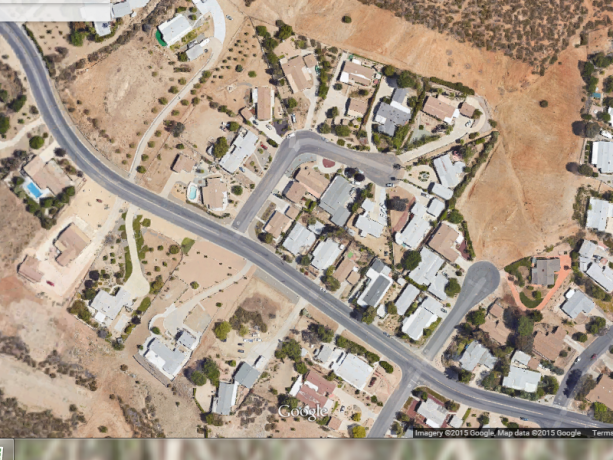
An area of Wildomar, surrounded by hillsides of chaparral that hasn’t been destroyed. These homes have mostly gravel yards and denuded, compacted backyards. Very little rain penetrates, and all the weeds that nature sends it to help repair this gash in the earth are promptly poisoned. This is death to us and our planet. By laying gravel you are turning soil into rock-hard dirt, because microbial life cannot live closely under it. That robs any plants you have stuck into the gravel of the food they need from the soil, which is opened up through microbial activity. You are adding to the heat value of the hardscape around your house causing you to cook in the summer and use more air conditioning. You have reduced habitat to zero. You have added to global warming by reflecting more heat and light into the sky. Although gravel is permeable, usually the ground below it bakes so hard that rain doesn’t percolate. I’ve read sites that want to you increase the albedo effect by laying gravel. In the short term albedo helps cool the atmosphere, but as a result of too much reflected light dries everything out. Think of the dark coolness and dampness of forests… that are now bare ground.
What do you do with your lawn instead? There are many choices that are so much better for the earth and your quality of life. First step, cut swales on contour on any slopes for best rain harvesting. Flat lawn? Easier still. Turn your lawn into a beautifully landscaped lush native garden. I’m not talking about a cactus here and there, but a creation with the awesome native plants we have in Southern California. Some of them such as Fremontia can die with supplemental summer water!

A beautiful border and plantings of California natives. Very low water use here, and very high habitat! There is a chocolate daisy that smells like chocolate. Oh yes. And how can you not want to plant something called Fairy Duster or Blue-Eyed Grass? A native landscape planted on soil that has been contoured to best catch and hold water, and amended with buried wet wood (hugelkultur), will give much-needed food, water and breeding grounds to countless birds, butterflies, native insects and honeybees.
Or put in a pond. Wait, a pond during a drought? Yes! Ninety-nine percent of California wetlands have been paved over, drained or are unusable. Where are all the animals drinking? Oh, wait, we are in the epicenter of extinction, mostly due to wetlands loss. There are very few animals left that need to drink. Those that are left have to take advantage of chlorinated water in bird baths and swimming pools. The microbially rich and diverse clean, natural water that fed and sustained life is just about gone. So what can you do? If you have a swimming pool, you can convert it either entirely to a pond, or into a natural swimming pool that is cleaned by plants.
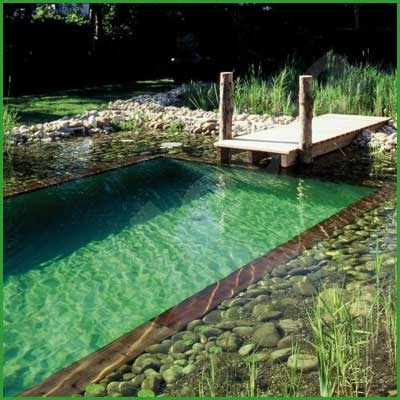
A natural pool upgrades your pool to a lovely pond without the use of chemicals. Suddenly instead of having this expensive eyesore that you use only a couple of months a year and pour chemicals into year-round, you have a lovely habitat that you want to sit and watch, and even better, swim in safely without turning your hair green or peeling your skin. You don’t need to clean the pool all the time, and you don’t need to put in chemicals. If you are in the San Diego or Los Angeles area, call Dr. Robert Lloyd of PuraVida Aquatics for a consultation and conversion. If you don’t have a pool, then build one that is cleaned by plants and fish. You don’t need a filtration or oxygenation system because the biology does it all. Where do you get the water from to top off your pond?
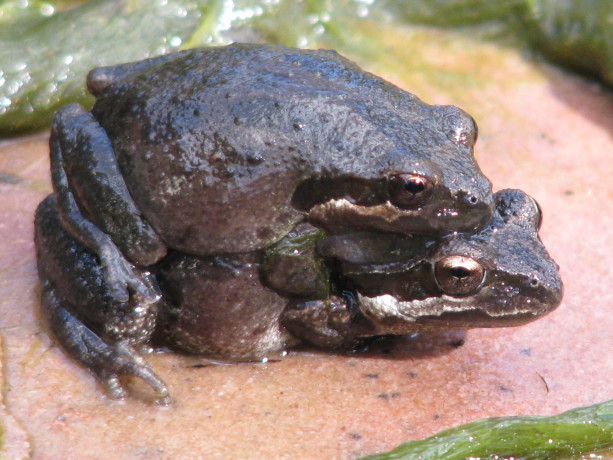
Native Pacific Chorus Frogs enjoying our clean pond at Finch Frolic Garden. Connect your pond to a lovely, planted stream that is connected to your laundry water or graywater system. You are buying water every day, so why not compost your water through phytoremediation and have a pond full of great healthy chemical-free water that is wonderful to look at and is an oasis for thirsty animals and insects?
Or install a food forest. With good soil building and rain catchment first, and planting in guilds with sheet mulch around trees and on pathways, you will be using a fraction of the water you pour on your lawn and yet harvest lots of food. Too much food? Share it with a food pantry!
Or start a veggie garden without digging any sod.

Create a lasagna garden right on top of the lawn and start growing immediately. Layer cardboard, sticks, grass, food scraps, leaves, more grass, more food scraps, more leaves and top it with about 8 inches of good soil, then plant right in it! That lovely standing compost heap will slowly turn into good soil while killing the grass beneath and growing crops for you immediately.
If ridding yourself of a lawn just breaks your heart, then substitute the high-water use grasses for a native grass mix that is comparable. Look at S&S Seeds for prices or for seed choices. Water a few times with Actively Aerated Compost Tea using any rainwater you may have caught in those 50-gallon containers and your grass roots will travel so deeply that they will find groundwater. Check up on the work of soil microbiologist Dr. Elaine Ingham and see how easy AACT is to make and use.
There are so many alternatives to using gravel that aren’t expensive, that are an investment in your property and in reclaiming habitat while beautifying your home and saving money. So please, just say, “NO,” to the gravel. Tell a friend!!
Which one of these would you rather live in? Which do you think is better for the earth and for the future generations?

Finch Frolic Garden, year 3. - Animals, Bees, Birding, Chickens, Compost, Fungus and Mushrooms, Gardening adventures, Heirloom Plants, Hugelkultur, Microbes and Fungi, Natives, Other Insects, Perennial vegetables, Pets, Predators, Rain Catching, Recycling and Repurposing, Reptiles and Amphibians, Seeds, Soil, Vegetables, Water Saving, Worms
Pathways Can Help Your Garden!
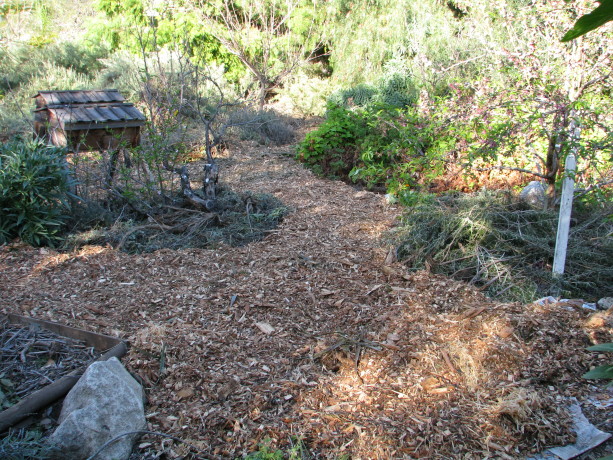
A finished section. Footpaths and/or vehicle access paths are absolutely necessary for any yard. Unfortunately, weeds love growing in them. Worse, the pressure from footfalls, wheelbarrows and vehicles compress and compact the soil, pressing the soil grains together so tightly that oxygen – and therefore life – can’t exist often up to several inches or more deep. Any life, that is, except for the grasses and other weeds that nature sends in to help repair the soil. Bare ground will be greatly compacted by rainfall, which will then erode paths as it runs, unable to soak through that spaceless ground. Once wet bare pathways are often unwalkable until they dry out, and have to be resmoothed. In our hot, dry areas, bare earth or graveled pathways reflect heat and light back up. That reflected heat and light dries out the underside of plant leaves, where species such as Live Oaks have over the millennium developed leaves that curl to expose less surface to the hot sun and to gather moisture underneath. Reflected heat and light dries out the air as well, and any hope of slight humidity to help water plants through months of dry heat is gone. If you have open-pollinated vegetables that rely on breeze for pollination, all that open pathway actually decreases your germination because pollen – such as from corn – will dry out in arid conditions. Humidity that you can keep in your garden will keep pollen more viable longer.

A wealth of freshly chipped wood – two dump-trucks full! The challenge: to spread it all in a week before our first tour. Yikes! What to do? Covering pathways with gravel is a common solution. I hate gravel. It heats up and becomes a thermal mass in the summer, further cooking your soil and air. It doesn’t suppress weeds and weed-whipping becomes an exercise in avoiding shrapnel. You can never get it out of the ground once you apply it, and chunks of gravel don’t do soil much good for planting. If you trip and fall on gravel it does terrible things to your knees – I had a piece lodged in my kneecap after a stumble some years ago (sorry for that cringe-worthy item).
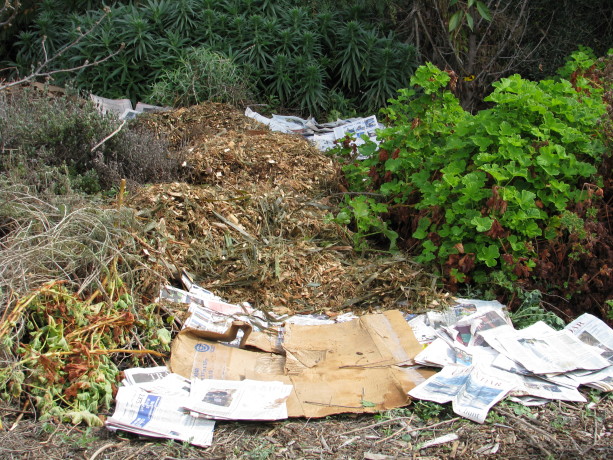
A 1/2 inch of cardboard or newspaper with mulch on top. Covering the soil is better, but not best. Bark will help rain bounce and then percolate, is dark so it won’t reflect light and heat as gravel does, and it decomposes. It is also expensive to buy, and because it decomposes you have to re-buy it every couple of years. Decomposing bark may be adding elements to your soil that you don’t want depending upon the source.
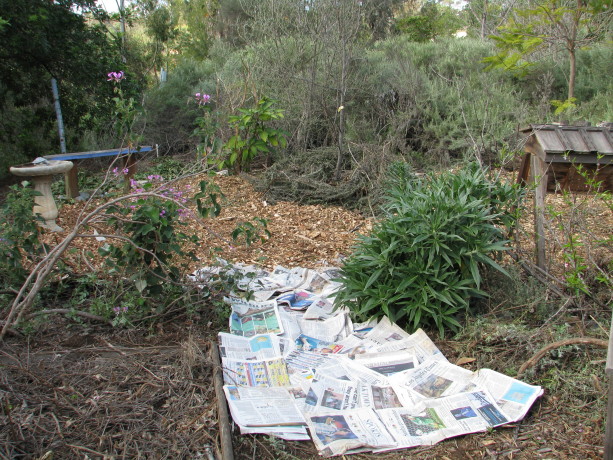
More progress as the afternoon wears on. I have experienced all the options above. The best method of countering all these issues that I have found also repurposes and recycles. Sheet mulch. Yep. You’ve heard it from me before and it proves itself every year. There is more to it, though.
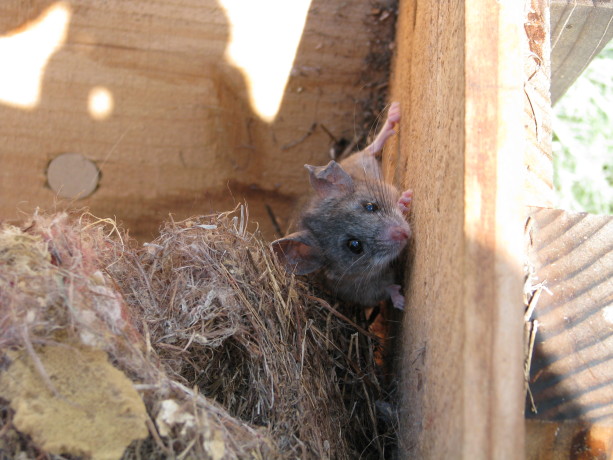
I disturbed a couple of nesting mice in one of the unused Kenya bee hives. First of all, please, please, please never use plastic. You can read about white pollution and the layers of plastic merging with topsoil in China and cringe. Plastic will not last. It will always be around in pieces. You will be poisoning your soil.
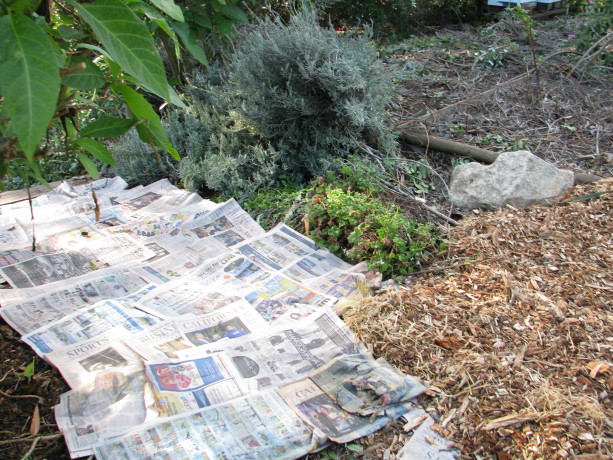
At the most basic, you can cover your pathways with 1/2″ of cardboard and newspaper, and top it with wood chips. I obtain my wood chips from arborists who save paying a dump fee by dumping it in my yard. If you’d rather have a more uniform look then purchase your bark. Either way the cardboard and newspaper will make the chips last years longer. More importantly the cardboard and newspaper form a protective, absorbent layer that protects the soil from compaction. Have you looked under a log or sheet of abandoned plywood in awhile? All the white tendrils of fungus, insects, worms, lizards and roots are thriving there along with billions of soil microbes all because they have that protective layer that keeps moisture in and compaction out. That microclimate is what you are forming with cardboard and mulch pathways. Since microbes free up the nutrients in the soil from which plants feed, you are creating more food sources for your plants. Tree and plant roots don’t end at the dripline, they reach out towards whatever source of water and nutrition they can find. If you are top-watering rather than deep-watering, then roots are abundant closer to the topsoil. By sheet mulching pathways you are extending food sources for your plants and trees, which now can stretch underneath the paths, link together with other roots through fungal networks, and become stronger and healthier. You also are creating habitat which is a food source for the entire food chain. Cooler, humid areas are better for bees and insects that pollinate, and the predators that feed upon them such as lizards, toads, frogs and birds. Just by sheet-mulching your pathways you are improving your environment as a whole. How can you NOT want to do this?

Sheet mulching around trees is much the same, except you add a little manure or compost tea if you have it. Sheet mulched pathways hold moisture and create some humidity which allows for better pollination and helps keep your plants from scorching in arid areas. If you live in a wet area or very humid area, use thicker layers of cardboard and mulch, which will help absorb moisture from the air and deliver it to the ground. Decomposition is quicker in wet areas, so using several inches of cardboard with mulch will last much longer and will again keep down compaction. Compaction in rainy areas is just as bad as in arid areas because of the erosion and flooding it causes.

More progress as the afternoon wears on. To catch rainwater and allow it to percolate into the soil rather than erode away topsoil, you dig rain catchment basins or swales. Swales are ditches with level bottoms, and can be a foot long (fishscale swales) or the length of your property. Swales should be positioned perpendicular to the flow of water. You can create swales across pathways, fill them with mulch, top them with cardboard or old plywood, and mulch on top to match the rest of the pathway. Water will be caught in the swales and won’t wash out paths on hillsides.
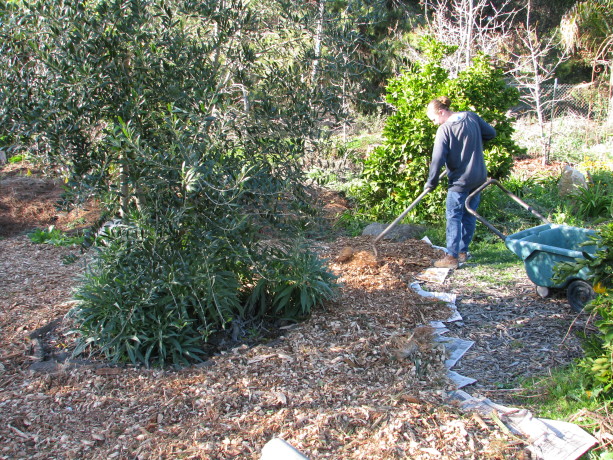
MIranda working on a large pathway near our large hugelbed. Going a step farther, you can ‘hugel swale’. Hugelkultur is layering woody material with dirt. This introduces organic material, oxygen and nutrient pathways into the soil and holds moisture into the dry season. You can dig deeply in your pathways, layer old wood (sticks, branches, logs, whatever you have) with the dirt, up to soil level, then sheet mulch. Your pathways are now waterharvesting alleys that you can walk on, and which will really feed your plants. And you just repurposed old woody cuttings.
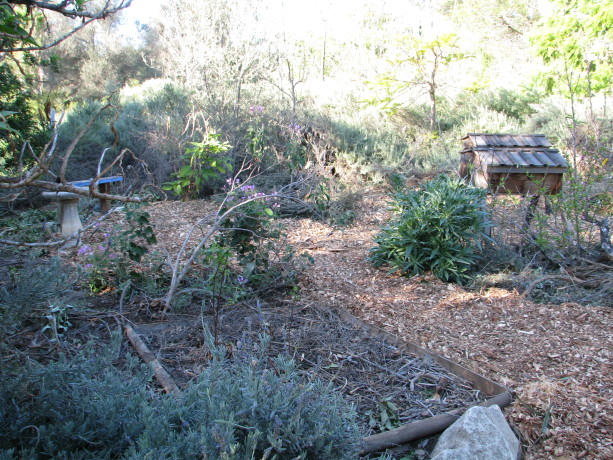
This mulch will greatly help the Asian pears and cherries which struggle with the dry heat of the summer. The ground will be kept moist and reduce evaporation, holding in humidity. We’ll be planting more heavily in this area, too. In very dry areas plants and trees do better in sunken beds, especially those that require a long chill time. Cold settles in holes. Moisture runs downhill, therefore dew will accumulate at the bottom of holes. You can either plant in holes and have your pathways higher, or if you have an established garden (such as I do) you can build up your pathways so that they become slightly higher than your trees and planting areas. We are working on that at Finch Frolic Garden, here in drought-stricken San Diego county.
So before I launch into yet another long lecture, the idea for pathways is simple: sheet mulch with cardboard and wood chips. If you live in a wet area, use several inches of both. If you live in a dry area, use no more than 1/2 inch of cardboard (or else it will absorb moisture from the soil) topped by at least an inch of mulch (no limit there!). If you want make super pathways, bury woody material before you sheet mulch. If you live in a dry area, raise your pathways above your planting beds. If you live in a wet area, lower your pathways so water can drain away from your plants (unless they love wet feet). Never use plastic, and please rethink gravel.
Then sit back and enjoy your yard and all the food and nutrients and abundance you have set the stage for, all using recycled materials that will last for years. Congratulations!

